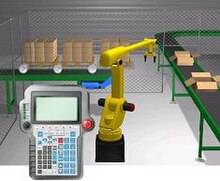
A simulation is an imitative representation of a process or system that could exist in the real world. In this broad sense, simulation can often be used interchangeably with model. Sometimes a clear distinction between the two terms is made, in which simulations require the use of models; the model represents the key characteristics or behaviors of the selected system or process, whereas the simulation represents the evolution of the model over time. Another way to distinguish between the terms is to define simulation as experimentation with the help of a model. This definition includes time-independent simulations. Often, computers are used to execute the simulation.
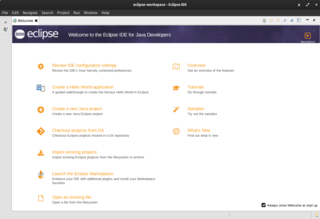
Eclipse is an integrated development environment (IDE) used in computer programming. It contains a base workspace and an extensible plug-in system for customizing the environment. It is the second-most-popular IDE for Java development, and, until 2016, was the most popular. Eclipse is written mostly in Java and its primary use is for developing Java applications, but it may also be used to develop applications in other programming languages via plug-ins, including Ada, ABAP, C, C++, C#, Clojure, COBOL, D, Erlang, Fortran, Groovy, Haskell, HLASM, JavaScript, Julia, Lasso, Lua, NATURAL, Perl, PHP, PL/I, Prolog, Python, R, Rexx, Ruby, Rust, Scala, and Scheme. It can also be used to develop documents with LaTeX and packages for the software Mathematica. Development environments include the Eclipse Java development tools (JDT) for Java and Scala, Eclipse CDT for C/C++, and Eclipse PDT for PHP, among others.
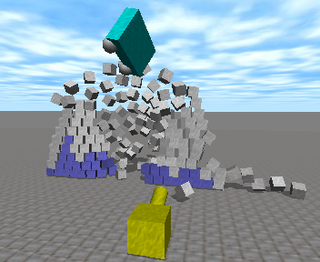
The Open Dynamics Engine (ODE) is a physics engine written in C/C++. Its two main components are a rigid body dynamics simulation engine and a collision detection engine. It is free software licensed both under the BSD license and the LGPL.

Microsoft Robotics Developer Studio is a discontinued Windows-based environment for robot control and simulation that was aimed at academic, hobbyist, and commercial developers and handled a wide variety of robot hardware. It requires a Microsoft Windows 7 operating system or later.
A robotics suite is a visual environment for robot control and simulation. They are typically an end-to-end platform for robotics development and include tools for visual programming and creating and debugging robot applications. Developers can often interact with robots through web-based or visual interfaces.

The Player Project creates free and open-source software for research into robotics and sensor systems. Its components include the Player network server and the Stage platform robotics simulators. Although accurate statistics are hard to obtain, Player is one of the most popular open-source robot interfaces in research and post-secondary education.

Webots is a free and open-source 3D robot simulator used in industry, education and research.

Robot Operating System is an open-source robotics middleware suite. Although ROS is not an operating system (OS) but a set of software frameworks for robot software development, it provides services designed for a heterogeneous computer cluster such as hardware abstraction, low-level device control, implementation of commonly used functionality, message-passing between processes, and package management. Running sets of ROS-based processes are represented in a graph architecture where processing takes place in nodes that may receive, post, and multiplex sensor data, control, state, planning, actuator, and other messages. Despite the importance of reactivity and low latency in robot control, ROS is not a real-time operating system (RTOS). However, it is possible to integrate ROS with real-time computing code. The lack of support for real-time systems has been addressed in the creation of ROS 2, a major revision of the ROS API which will take advantage of modern libraries and technologies for core ROS functions and add support for real-time code and embedded system hardware.
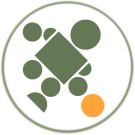
SimSpark is a generic simulation system for various multiagent simulations. It supports developing physical simulations for AI and robotics research with an open-source application framework. It is commonly used in academic research and education.

RoboLogix is a robotics simulator which uses a physics engine to emulate robotics applications. The advantages of using robotics simulation tools such as RoboLogix are that they save time in the design of robotics applications and they can also increase the level of safety associated with robotic equipment since various "what if" scenarios can be tried and tested before the system is activated. RoboLogix provides a platform to teach, test, run, and debug programs that have been written using a five-axis industrial robot in a range of applications and functions. These applications include pick-and-place, palletizing, welding, and painting.
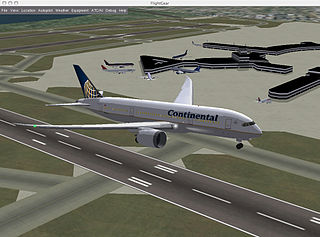
A flight simulation video game refers to the simulation of various aspects of flight or the flight environment for purposes other than flight training or aircraft development. A significant community of simulation enthusiasts is supported by several commercial software packages, as well as commercial and homebuilt hardware. Open-source software that is used by the aerospace industry like FlightGear, whose flight dynamics engine (JSBSim) is used in a 2015 NASA benchmark to judge new simulation code to space industry standards, is also available for private use. A popular type of flight simulators video games are combat flight simulators, which simulate combat air operations from the pilot and crew's point of view. Combat flight simulation titles are more numerous than civilian flight simulators due to variety of subject matter available and market demand.

The RoboCup 2D Simulated Soccer League is the oldest of the RoboCup Soccer Simulation Leagues. It consists of a number of competitions with computer simulated soccer matches as the main event.

The RoboCup 3D Simulated Soccer League allows software agents to control humanoid robots to compete against one another in a realistic simulation of the rules and physics of a game of soccer. The platform strives to reproduce the software programming challenges faced when building real physical robots for this purpose. In doing so, it helps research towards the RoboCup Federation's goal of developing a team of fully autonomous humanoid robots that can win against the human world soccer champion team in 2050.

Advanced Simulation Library (ASL) is a free and open-source hardware-accelerated multiphysics simulation platform. It enables users to write customized numerical solvers in C++ and deploy them on a variety of massively parallel architectures, ranging from inexpensive FPGAs, DSPs and GPUs up to heterogeneous clusters and supercomputers. Its internal computational engine is written in OpenCL and utilizes matrix-free solution techniques. ASL implements variety of modern numerical methods, i.a. level-set method, lattice Boltzmann, immersed boundary. The mesh-free, immersed boundary approach allows users to move from CAD directly to simulation, reducing pre-processing efforts and number of potential errors. ASL can be used to model various coupled physical and chemical phenomena, especially in the field of computational fluid dynamics. It is distributed under the free GNU Affero General Public License with an optional commercial license.
RoboDK is an offline programming and simulation software for industrial robots. The simulation software allows you to program robots outside the production environment, eliminating production downtime caused by shop floor programming.
Gazebo is an open-source 2D/3D robotics simulator that began development in 2002. In 2017, development forked into two versions, known as "Gazebo", the original monolithic architecture, and "Ignition", which had moved to becoming a modernized collection of loosely coupled libraries. Following a trademark obstacle in 2022 regarding their use of the name "Ignition", Open Robotics took the opportunity to switch the version names, dubbing the original fork "Gazebo Classic" and the new, modern fork "Gazebo".
AirSim is an open-source, cross platform simulator for drones, ground vehicles such as cars and various other objects, built on Epic Games’ proprietary Unreal Engine 4 as a platform for AI research. It is developed by Microsoft and can be used to experiment with deep learning, computer vision and reinforcement learning algorithms for autonomous vehicles. This allows testing of autonomous solutions without worrying about real-world damage.
CoppeliaSim, formerly known as V-REP, is a robot simulator used in industry, education and research. It was originally developed within Toshiba R&D and is currently being actively developed and maintained by Coppelia Robotics AG, a small company located in Zurich, Switzerland.
